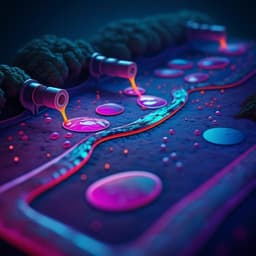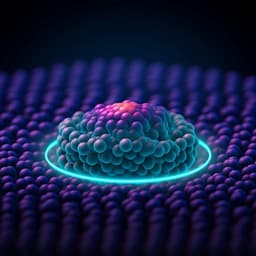
Engineering and Technology
Generalised optical printing of photocurable metal chalcogenides
S. Baek, H. W. Ban, et al.
This innovative research conducted by Seongheon Baek, Hyeong Woo Ban, Sanggyun Jeong, and colleagues presents a novel optical printing technique to fabricate functional metal chalcogenides. By utilizing photocurable inks, they create intricate 2D and 2.5D patterns, showcasing potential applications in cost-effective architecture for functional inorganic materials.
Playback language: English
Introduction
Material patterning is crucial for electronic, optoelectronic, and energy devices. Traditional methods like photolithography are costly and multi-step. Optical 3D printing techniques (DLP, SLA) offer simplicity and cost-effectiveness through additive manufacturing, but are limited to photocurable polymers. Direct ink writing (DIW) uses inorganic-containing inks but lacks the high resolution and throughput of optical printing. Metal chalcogenides are attractive materials for various applications but patterning them remains challenging. This work aims to overcome the limitations of current techniques by developing a generalized direct optical printing method for functional metal chalcogenides using photocurable inks, enabling simple and cost-effective 2D and 2.5D device fabrication. The research focuses on developing universally applicable photocurable chalcogenidometallate (ChaM) inks for DLP printing, expanding the range of printable materials beyond photopolymers and enabling the creation of high-resolution patterns of diverse metal chalcogenides.
Literature Review
The existing literature highlights the limitations of conventional 2D patterning techniques for high-resolution structures. These techniques, while providing high-resolution patterns, are often expensive and involve multiple steps. Existing 3D printing techniques such as DLP and SLA are limited by the availability of suitable photocurable materials, primarily photocurable polymers and their composites. Previous work on direct optical lithography of inorganic nanomaterials involved spin-coating photocurable nanoparticle films followed by photolithography and lift-off, which is still a multi-step process. Chalcogenidometallates (ChaMs) have shown potential as soluble semiconductor precursors for ink-processed patterning of metal chalcogenides due to their ability to form crystalline metal chalcogenide phases upon thermal decomposition. This study aims to bridge the gap by combining the advantages of DLP printing with the versatility of ChaMs to create a generalized method for direct optical printing of various metal chalcogenides.
Methodology
The researchers developed a digital light processing (DLP)-based optical printing technique using photocurable chalcogenidometallate (ChaM) inks. Various ChaMs containing Pt, Sb, Sn, Cu, and Mo were synthesized by dissolving metal chalcogenide powders using an ethylenediamine/ethanethiol alkahest or traditional coordination chemistry. These ChaMs were then mixed with photoacid generators (PAGs), such as MFVT and IM-NIT, to formulate photocurable inks. The purification of ChaMs was crucial for ensuring photocurability. The basic reaction medium was replaced with polar solvents like NMF or DMSO. The photocuring mechanism involves UV irradiation triggering PAG decomposition, releasing protons that react with ChaM anions, causing precipitation of the metal chalcogenides. The DLP process utilizes a digital micro-mirror device to selectively solidify the ink, creating patterns layer by layer. The printed metal chalcogenides were then subjected to post-heating treatment under an inert atmosphere to achieve thermal decomposition and crystallization. The researchers characterized the printed materials using various techniques, including SEM, XRD, Raman spectroscopy, and Hall measurements to assess their microstructures, crystallinity, and electrical properties. A micro-scale thermoelectric generator was fabricated using patterned SnSe2 and Cu2S legs, and its power density was evaluated under a temperature difference. The synthesis of each ChaM involved specific steps, tailored to the individual material's properties and solubility requirements. The purification of the inks was achieved by solvent exchange and centrifugation. The DLP printing process involved using commercially available and custom-built DLP systems, with the choice of system dependent on the scale and resolution required. Post-processing of the printed materials consisted of heat treatment in a controlled atmosphere to promote crystallization and phase formation. Characterization methods included SEM for morphology, XRD for crystallinity, Raman for vibrational analysis, and Hall measurements for electrical properties.
Key Findings
The researchers successfully demonstrated the direct optical printing of various metal chalcogenides, including Sb2S3, Sb2Se3, SnSe, SnSe2, Cu2S, SnS, MoS2, and PtS2, using their developed photocurable ChaM-based inks and DLP printing. The printed structures exhibited excellent shape fidelity, uniformity, and high throughput. Line widths as small as 10 μm were achieved, demonstrating high-resolution printing capabilities. The printing process allows for the creation of complex 2D patterns with multiple materials and 2.5D architectures via layer-by-layer curing. Material characterizations confirmed the high crystallinity and controllable micro-scale crystallographic textures of the printed metal chalcogenides. The printed Cu2S and SnSe2 exhibited p-type and n-type semiconductor behavior, respectively, with carrier mobilities comparable to those reported in the literature for similar materials fabricated using traditional lithographic techniques. The thermoelectric properties of the printed Cu2S and SnSe2 were also characterized, demonstrating their functionality. A micro-scale thermoelectric generator was fabricated using DLP-printed Cu2S and SnSe2 legs. This device achieved a power density of 0.564 mW cm⁻² under a temperature difference of 65 K. A cross-plane thermoelectric device also showed promising power generation performance. The study shows that the DLP printing process led to dense, smooth, and high-quality metal chalcogenide microstructures without significant voids or pores. The controlled heat treatment allowed for the modulation of the composition and phase of the printed materials. The versatility of the method allows for creating complex patterns and multi-material structures with high fidelity, high-throughput, and controlled crystallinity.
Discussion
This work successfully demonstrates a novel and efficient approach to printing functional inorganic materials, specifically metal chalcogenides, offering a significant advance over existing techniques. The combination of DLP printing with photocurable ChaM inks enables a maskless, additive manufacturing process, eliminating the need for multiple steps and reducing costs associated with traditional lithography. The successful fabrication and evaluation of a micro-scale thermoelectric generator highlight the potential applications of this technology in energy harvesting and other micro-device fabrication. The results are significant because they expand the material selection for optical printing to include inorganic semiconductors, enabling the creation of highly functional micro- and nanoscale devices. The high resolution and throughput offered by this technique open up new possibilities for developing advanced electronic, optoelectronic, and energy devices with intricate designs. Further research could focus on improving the scalability and throughput of the technique, exploring other types of metal chalcogenides and expanding the range of functional devices that can be fabricated using this method.
Conclusion
This study established a generalized, DLP-based optical printing technology for producing diverse crystalline metal chalcogenides with 2D and 2.5D architectures. Photocurable ChaM-based inks enabled facile fabrication of various inorganic materials with excellent shape uniformity and fidelity. The method's universal printability, demonstrated through the creation of a micro-scale thermoelectric generator, provides a cost-effective, simple, and high-resolution direct architecturing process for inorganic materials. Future research should focus on exploring higher-resolution equipment (two-photon lithography) to further refine the technique.
Limitations
The current study primarily focuses on the printing and characterization of relatively simple patterns and structures. While the achieved resolution is impressive, further investigation is needed to assess the scalability of the process for creating more complex three-dimensional architectures. The electrical properties of the printed materials are still lower than those of bulk materials, indicating potential limitations in charge carrier mobility due to the presence of grain boundaries and other defects. This requires further optimization of the ink formulation and printing parameters. The study focuses on a limited number of metal chalcogenides; broader exploration of the applicability of this method to other inorganic materials is needed. Finally, the long-term stability and reliability of the printed devices require further investigation.
Related Publications
Explore these studies to deepen your understanding of the subject.







